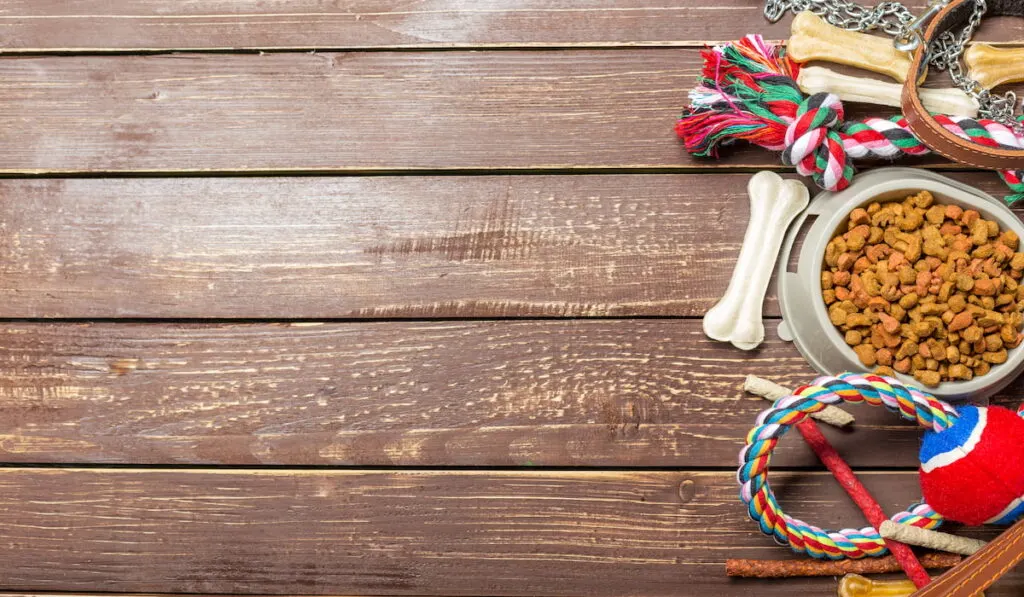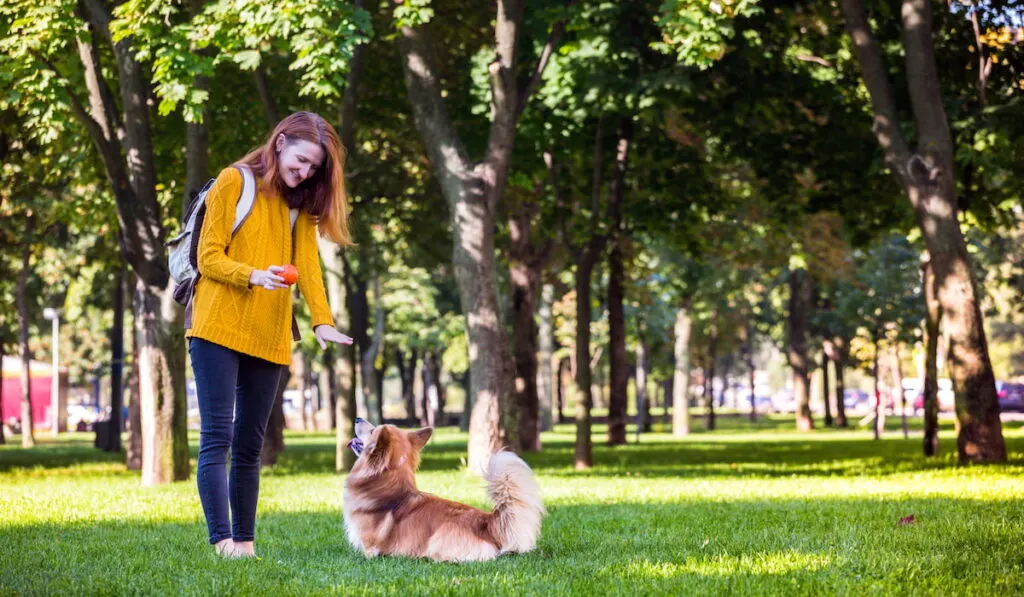Potty training a new puppy is always a challenge, especially if you live in an upstairs apartment. Have no fear though, it can be done! With a little dedication and a lot of consistency, your puppy can be fully potty trained, regardless of where you live.
If you live in an upstairs apartment, you can potty train your puppy by following a few simple rules and sticking to a plan. This might include buying a crate, making a puppy potty area and/or scheduling frequent walks to avoid accidents.
All puppies will have accidents along the way, and sometimes you might feel like giving up, but if you stay the course you can potty train your puppy.

Many people may think that they cannot have a puppy if they live in an upstairs apartment because they think that potty training is impossible. Luckily, this is not the case. The following guide will help you formulate a potty-training plan and successfully potty train your dog.
Table of Contents
Before You Get Your Puppy
There are a few things you need to do before you get your puppy. If you already have your puppy, you can do these things now before you start your potty-training program.
Buy a Crate
If you plan on using the crate training puppy, the first thing you will need is a crate. You want a crate large enough that your puppy has plenty of room to move, stand and be comfortable. You may have to get a bigger crate as your dog grows.
Remember that a crate that is too big is not as effective. Some crates even have dividers so they can expand as your puppy grows.
Create a Puppy Area in Your Apartment
Some dog owners do not want to use crates, and that is okay. If you do not want to use a crate, you can set up a separate, quiet area for your dog. The area should be free of anything dangerous for your puppy to chew like electrical cords and any valuables. You can put a bed in there with their food and water bowls along with some toys.
You want it to be a comfortable place secured with a gate of some kind to keep them inside. This is where you will put your puppy to keep them from running around the apartment and possibly using the potty inside when you are busy.
Puppy Accessories

You also need to get a leash, harness, and a pet waste bag dispenser to attach to your leash. Most apartment complexes require dog owners to use pet waste bags to keep shared gardens or patios clean. It is also much easier to coax a puppy to walk with a harness than a collar that can pinch or bind if they fight it.
Make A Commitment To Be Consistent
The most important part of potty-training a puppy is to remain consistent throughout the process. Living in an upstairs apartment does make the thought of going outside 6 times a day seem exhausting, but it will not be that way forever! There are also a few alternative potty training options that will help along the way.
Things To Keep In Mind

There are a few things that new puppy owners need to keep in mind when formulating their potty-training plan.
Puppies Need To Potty A Lot!
Puppies can only hold their urine for a short amount of time. Typically, they can only hold it for about 4 hours at 3 months old. As the months progress, your puppy will be able to hold it longer.
This means that your puppy will need to go out multiple times a day, once right before bed, and maybe even once through the night. Keep this in mind when you design your potty-training plan for your new puppy.
Limit Water Before Bedtime
Just like children, puppies need to have limited access to water directly before bedtime. You do not want them drinking water right before they go to bed. If you plan on going to bed at 10 p.m., stop giving them water at 8. This gives them enough time to process that water and pee right before bedtime.
Puppies Need Positive Reinforcement
When your puppy does something good potty-wise, reward them with positive reinforcements. You can do this by giving them a small healthy treat or by simply telling them that they did well and petting them on the head.
Rewards let them know that they are doing the right thing and they will continue doing it hoping to be rewarded. Over time, you can phase out rewarding them each time, once they have gotten the hang of it.
Weighing Your Options
Your puppy will need to go out first thing in the morning when they wake up. Just like humans need to potty when they first get up, so do puppies! Since you live upstairs, you might need to make some accommodations.
Take Them Outside
The ideal situation would be taking your puppy down the stairs and to a patch of grass to potty. Many apartment complexes have a designated area for this.
It is recommended that for at least a few weeks, for the first pee of the day, you carry the puppy down the stairs to the patch of grass. If you can’t carry them, keep them moving on a lead to keep them from peeing along the way.
If you have a roommate or neighbor, consider exchanging dog walking services. The more often you can take your puppy out, the faster he will be potty trained.
Pee Pads
Sometimes making it all the way downstairs 6 times a day may not be possible for you. This is where pee pads can come into play. You will want to put the pee pads in an area away from foot traffic. You can put them in the puppy area or in another spot, but wherever you put it, make that the designated pee pad area.
You want to maintain consistency. You also do not have to use pee pads exclusively; you can do a combination of taking the puppy outside and using the pee pads for emergencies.
Many people advise against using pee pads. Remember, the person giving that advice may not live in an upstairs apartment! Pee pads can help you out until your puppy is able to hold it longer. Once that happens, you can phase out the pee pad.
- INCLUDES: 100 Regular-size standard-absorbency puppy pee pads; ideal for puppy training, senior dogs, car trips, and more
- 5-LAYER PROTECTION: Multi-layer construction with quick-dry surface and absorbent core that turns liquid into gel on contact
- LEAKPROOF: Plastic lining keeps floors safe from damage; plastic border on all 4 sides to prevent overflow
- BUILT-IN ATTRACTANT: Helps aid in potty training
- PRODUCT DIMENSIONS: 22 x 22 inches (LxW, overall); 19 x 19 inches (LxW, center pad); 1.65 inch border
Fake Grass Potty Trainers
If you are worried about using pee pads, you can use a fake grass potty trainer instead. These potty areas give the illusion of grassy areas, but you can have them indoors or on your balcony if you have one that is safe for puppies.
These grassy pads are easy to clean and you can spray them off with a hose. You can phase these out once your puppy is able to hold it longer.
- DOG GRASS PAD WITH TRAY – This artificial turf dog pee pad provides a sanitary place for your pet to relieve themselves inside or on your balcony or patio. It’s a reusable alternative to disposable dog training pads for small to medium-sized pets.
- EASY PUPPY TRAINING – Potty training your new best friend just got easier, even if you live in an apartment or work long hours. This washable dog grass pad helps avoid accidents while enforcing your pup’s training that they should go potty on grass.
- THREE-LAYER SYSTEM – The artificial dog grass mat sits on top of a secure plastic drainage insert that allows liquid to empty into the durable collection puppy pad holder to avoid messes and spills.
Prepare For Accidents
Accept the fact now that your puppy will have a few accidents along the way. When puppies are young, they just cannot hold their pee. If you are unable to take them downstairs or to a potty area quickly enough, they may have an accident. Over time, they will be able to hold it until you can get them there.
When your puppy has an accident in the apartment, don’t panic. If you catch them in the act, tell them “no” sternly and take them to a potty area. Always remember, they are puppies and they are still learning and growing. They will get the hang of it eventually!
Rules To Train Your Puppy By

1. Stay Consistent.
Learn your puppy’s potty schedule and take them to potty multiple times a day. Sometimes they may not need to potty, but you still want to give them the opportunity.
The key times are first thing when they wake up, a few times throughout the day, once right before bedtime, and sometimes in the middle of the night if they wake up and need to go. Stick to the puppy’s potty schedule even if you do not feel like taking them. This will prevent most accidents and teach your puppy where the designated potty area is.
2. Accept That There Will Be Accidents.
You cannot change the fact that accidents will happen, especially when you live in an upstairs apartment. You do not have the convenience of letting them out the back door like other puppy owners can.
Pee pads or grassy pads may be your saving grace in this case. Either way, the accidents will subside, and you will get through this.
3. Reward Your Puppy When They Succeed.
Always reward your puppy for using the potty in the right area. Use treats or simple positive reinforcements like petting them and telling them how good they did. These simple actions just help them know that what they are doing is right.
Can I Leave My Puppy On The Balcony
Responsible dog owners anywhere will tell you that leaving a puppy on your apartment balcony is not ideal. It can be unsafe and also create behavior issues in your puppy.
Remember that a balcony is not the same as a crate. The size makes it much less effective as a potty training tool.
If you do have a balcony, be sure to puppy proof it to keep your pup safe.
3 Tips for Making Your Balcony Safer for Your Puppy
- Install a railing guard. Install a railing guard (there are many inexpensive options on Amazon.com)so that your puppy cannot accidentally slide through the railings and fall.
- Make sure furniture is placed so that your puppy cannot climb up and jump out.
- Make sure there is adequate shade.
A balcony can be a great place to set up a puppy potty station to use when you need to take your puppy out late at night or early in the morning. Be sure your puppy always has supervision when on the balcony.
Final Thoughts
Potty training any puppy is a challenging task, but it can be even more challenging when you live in an upstairs apartment. Thankfully, there are a few helpful supplies like pee pads and grassy pads that will help you get through the early days. Just remain consistent and be patient. With the right plan you can potty train your puppy just the same as everyone else. Good luck!
